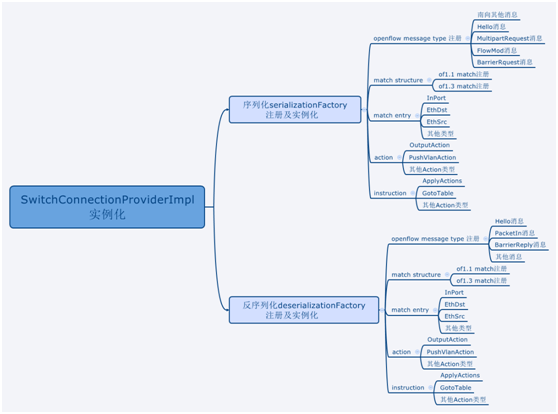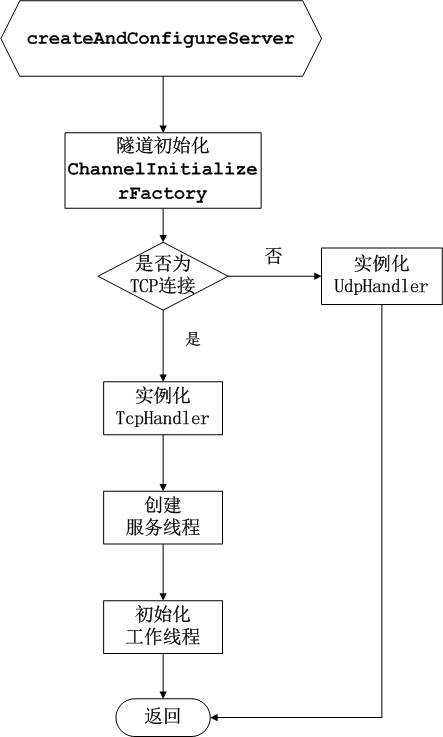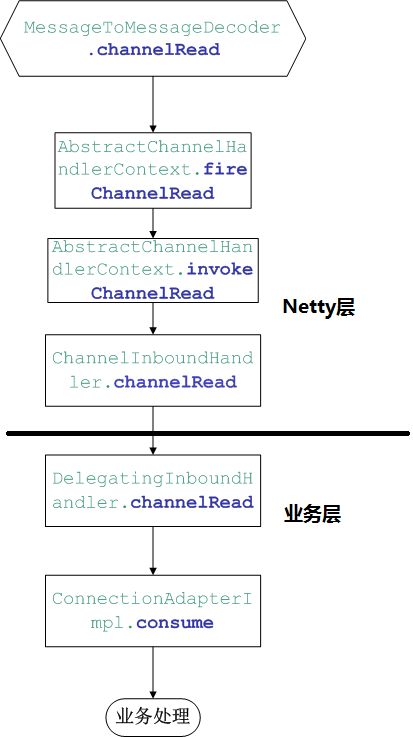基于ODL开发已经有一段时间了,对于一个全新的平台,总是喜欢每隔一段时间就总结一番,本篇算是第一篇吧。下面会介绍以下内容:
1.openflow服务注册
2.netty服务创建
3.序列化、反序列化工作原理
4.从hello到of-session
一、前提
Openflowjava是基于netty进行的开发,在阅读Openflowjava的源码的时候需要简单了解一下netty原理。
Openflowjava是一个独立的线程,功能入口函数是SwitchConnectionProviderImpl.java中startup函数。因此以类SwitchConnectionProviderImpl为起点进行展开分析。
二、Openflow服务注册
openflowjava使用了多种设计模式,例如生产者-消费者、工厂模式等。通过类名SwitchConnectionProviderImpl便知,连接管理服务使用的生产者-消费者模式(openflowjava是生成者,openflowplugin是消费者)。我们先看一下构造函数:
|
1
2
3
4
5
6
7
8
9
10
11
12
13
14
|
/
*
*
Constructor
*
/
public
SwitchConnectionProviderImpl
(
)
{
/
/ 序列化工厂注册 底层实现就是初始化
map
serializerRegistry
=
new
SerializerRegistryImpl
(
)
;
serializerRegistry
.init
(
)
;
serializationFactory
=
new
SerializationFactory
(
)
;
serializationFactory
.setSerializerTable
(
serializerRegistry
)
;
/
/ 反序列化工厂注册 底层实现就是初始化
map
deserializerRegistry
=
new
DeserializerRegistryImpl
(
)
;
deserializerRegistry
.init
(
)
;
deserializationFactory
=
new
DeserializationFactory
(
)
;
deserializationFactory
.setRegistry
(
deserializerRegistry
)
;
}
|
通过成员变量名称知道,序列化和反序列化采用工厂模式,由于openflow消息很多,因此采用工厂模式即可针对不同的消息,实例化不同的对象,以达到统一处理。下面是消息注册的整体组织架构图:

由此结构图可知,序列化和反序列化工厂注册消息结构类似,里面的消息类型基本是对应的,如:hellorequest和helloreply,barrierrequest和barrierreply等。
上面这个结构图信息来自serializerRegistry.init()和deserializerRegistry.init();方法,在进行展开说明。这里想说一下,大多数都基于odl进行二次开发,因此很多时候需要扩展openflow消息,通过上面结构图,如果扩展openflow消息,则需要在openflow message type增加对应代码,如果扩展flowmod则需要在match entry增加对应代码。
通过上图我们能做到,当我们扩展openflow协议的时候,在哪里增加代码即可,内部代码实现需要我们自己去深入分析。
三、 netty服务创建
上面已经分析过,startup是openflowjava入口函数,此函数比较简单,如下所示:
|
1
2
3
4
5
6
7
8
9
10
11
12
13
14
15
16
17
18
|
@
Override
public
ListenableFuture
<
Boolean
>
startup
(
)
{
LOGGER
.debug
(
"Startup summoned"
)
;
ListenableFuture
<
Boolean
>
result
=
null
;
try
{
serverFacade
=
createAndConfigureServer
(
)
;
/
/这个函数是重点,根据配置创建
netty服务
if
(
switchConnectionHandler
==
null
)
{
throw
new
IllegalStateException
(
"SwitchConnectionHandler is not set"
)
;
}
new
Thread
(
serverFacade
)
.start
(
)
;
/
/线程启动
result
=
serverFacade
.getIsOnlineFuture
(
)
;
}
catch
(
Exception
e
)
{
SettableFuture
<
Boolean
>
exResult
=
SettableFuture
.create
(
)
;
exResult
.setException
(
e
)
;
result
=
exResult
;
}
return
result
;
}
|
方法createAndConfigureServer主要流程图框架,如下图所示:

我们在来看一下代码,这部分需要有一定的netty框架的基础知识:
|
1
2
3
4
5
6
7
8
9
10
11
12
13
14
15
16
17
18
19
20
21
22
23
24
25
26
27
28
29
30
31
32
33
34
35
36
37
38
|
/
*
*
*
@
return
*
/
private
ServerFacade
createAndConfigureServer
(
)
{
LOGGER
.debug
(
"Configuring .."
)
;
ServerFacade
server
=
null
;
/
/实例化
Channel,主要初始化序列化和反序列化工厂对象
ChannelInitializerFactory
factory
=
new
ChannelInitializerFactory
(
)
;
factory
.setSwitchConnectionHandler
(
switchConnectionHandler
)
;
factory
.setSwitchIdleTimeout
(
connConfig
.getSwitchIdleTimeout
(
)
)
;
factory
.setTlsConfig
(
connConfig
.getTlsConfiguration
(
)
)
;
factory
.setSerializationFactory
(
serializationFactory
)
;
factory
.setDeserializationFactory
(
deserializationFactory
)
;
/
/根据不同协议类型,创建不同
netty的服务,针对
openflow协议来说,我们是
TCP服务
TransportProtocol
transportProtocol
=
(
TransportProtocol
)
connConfig
.getTransferProtocol
(
)
;
if
(
transportProtocol
.equals
(
TransportProtocol
.TCP
)
||
transportProtocol
.equals
(
TransportProtocol
.TLS
)
)
{
/
/创建
tcp服务
server
=
new
TcpHandler
(
connConfig
.getAddress
(
)
,
connConfig
.getPort
(
)
)
;
/
/实例化
TcpHandler
/
/初始化服务线程
TcpChannelInitializer
channelInitializer
=
factory
.createPublishingChannelInitializer
(
)
;
(
(
TcpHandler
)
server
)
.setChannelInitializer
(
channelInitializer
)
;
(
(
TcpHandler
)
server
)
.initiateEventLoopGroups
(
connConfig
.getThreadConfiguration
(
)
)
;
/
/初始化工作线程
NioEventLoopGroup
workerGroupFromTcpHandler
=
(
(
TcpHandler
)
server
)
.getWorkerGroup
(
)
;
connectionInitializer
=
new
TcpConnectionInitializer
(
workerGroupFromTcpHandler
)
;
connectionInitializer
.setChannelInitializer
(
channelInitializer
)
;
connectionInitializer
.run
(
)
;
/
/这个地方很重要,调用
run方法。下面会进行分析。
}
else
if
(
transportProtocol
.equals
(
TransportProtocol
.UDP
)
)
{
/
/创建
UDP服务
server
=
new
UdpHandler
(
connConfig
.getAddress
(
)
,
connConfig
.getPort
(
)
)
;
(
(
UdpHandler
)
server
)
.setChannelInitializer
(
factory
.createUdpChannelInitializer
(
)
)
;
}
else
{
throw
new
IllegalStateException
(
"Unknown transport protocol received: "
+
transportProtocol
)
;
}
server
.setThreadConfig
(
connConfig
.getThreadConfiguration
(
)
)
;
return
server
;
}
|
上面这些内容,大部分都是基于netty接口实现的,本人也只是了解一点netty,这不能做深入分析。我们接下来看一下上面提到的run方法,其实run方法很简单,里面只是调用了set方法:
|
1
2
3
4
5
6
|
@
Override
public
void
run
(
)
{
b
=
new
Bootstrap
(
)
;
b
.group
(
workerGroup
)
.channel
(
NioSocketChannel
.class
)
.handler
(
channelInitializer
)
;
/
/
handler设置,业务处理逻辑层
}
|
这个地方的channelInitializer是主要作用是注册业务处理,即当接收到一个网络数据包时应该如何对其进行解析。在查看类TcpChannelInitializer的具体实现时候主要看方法initChannel,这个方法是一个接口,主要用于netty框架调用。先简单介绍一下netty处理报文机制:
Netty中的所有handler都实现自ChannelHandler接口,按照输入输出方向来划分,可分为ChannelInboundHandler、ChannelOutboundHandler两大类。
ChannelInboundHandler对从客户端发往服务器的报文进行处理,一般用来执行解码、读取客户端数据、进行业务处理等;
ChannelOutboundHandler对从服务器发往客户端的报文进行处理,一般用来进行编码、发送报文到客户端。
inbound 的处理顺序是与 add 顺序一致的, 而 outbound 的处理顺序是跟 add 顺序相反的。
有两点需要特别说明:
1)inbound格式的数据流处理完成后不会进入outbound处理流程。也就是说一个流要么进入inbound要进入outbound。
2)进入流水线之后,上一个处理流程的输出结果,可能会作为下一个处理流程的输入。注意是可能而不是必须。
我们来看一下代码:
|
1
2
3
4
5
6
7
8
9
10
11
12
13
14
15
16
17
18
19
20
21
22
23
24
25
26
27
28
29
30
31
32
33
34
35
36
37
38
39
40
41
42
43
44
45
46
47
48
49
50
51
52
53
54
55
56
57
|
@
Override
protected
void
initChannel
(
final
SocketChannel
ch
)
{
if
(
ch
.remoteAddress
(
)
!=
null
)
{
/
/ 当一个
client请求连接到来时,进行判断是否允许访问
/
/ 在第二次开发的时候可以在这里进行访问控制。
/
/ 比如说:黑名单
ip不允许访问
InetAddress
switchAddress
=
ch
.remoteAddress
(
)
.getAddress
(
)
;
int
port
=
ch
.localAddress
(
)
.getPort
(
)
;
int
remotePort
=
ch
.remoteAddress
(
)
.getPort
(
)
;
LOGGER
.debug
(
"Incoming connection from (remote address): {}:{} --> :{}"
,
switchAddress
.toString
(
)
,
remotePort
,
port
)
;
if
(
!
getSwitchConnectionHandler
(
)
.accept
(
switchAddress
)
)
{
ch
.disconnect
(
)
;
LOGGER
.debug
(
"Incoming connection rejected"
)
;
return
;
}
}
/
/通过上面
if判断后则表示允许连接
LOGGER
.debug
(
"Incoming connection accepted - building pipeline"
)
;
allChannels
.add
(
ch
)
;
ConnectionFacade
connectionFacade
=
null
;
/
/设置连接属性,如超时时间
connectionFacade
=
connectionAdapterFactory
.createConnectionFacade
(
ch
,
null
)
;
try
{
LOGGER
.debug
(
"calling plugin: {}"
,
getSwitchConnectionHandler
(
)
)
;
getSwitchConnectionHandler
(
)
.onSwitchConnected
(
connectionFacade
)
;
connectionFacade
.checkListeners
(
)
;
ch
.pipeline
(
)
.addLast
(
PipelineHandlers
.IDLE_HANDLER
.name
(
)
,
new
IdleHandler
(
getSwitchIdleTimeout
(
)
,
TimeUnit
.MILLISECONDS
)
)
;
boolean
tlsPresent
=
false
;
/
/
If
this
channel
is
configured
to
support
SSL
it
will
only
support
SSL
if
(
getTlsConfiguration
(
)
!=
null
)
{
/
/
TLS连接处理
…
}
/
/ 流水线处理注册 注册
ChannelInboundHandlerAdapter
ch
.pipeline
(
)
.addLast
(
PipelineHandlers
.OF_FRAME_DECODER
.name
(
)
,
new
OFFrameDecoder
(
connectionFacade
,
tlsPresent
)
)
;
/
/
openflow头解析
ch
.pipeline
(
)
.addLast
(
PipelineHandlers
.OF_VERSION_DETECTOR
.name
(
)
,
new
OFVersionDetector
(
)
)
;
/
/
openflow版本号解析
OFDecoder
ofDecoder
=
new
OFDecoder
(
)
;
/
/实例化反序列化对象并加到
ofDecoder
.setDeserializationFactory
(
getDeserializationFactory
(
)
)
;
ch
.pipeline
(
)
.addLast
(
PipelineHandlers
.OF_DECODER
.name
(
)
,
ofDecoder
)
;
/
/流水线处理注册 注册
ChannelOutboundHandlerAdapter
OFEncoder
ofEncoder
=
new
OFEncoder
(
)
;
/
/实例化序列化对象
ofEncoder
.setSerializationFactory
(
getSerializationFactory
(
)
)
;
ch
.pipeline
(
)
.addLast
(
PipelineHandlers
.OF_ENCODER
.name
(
)
,
ofEncoder
)
;
/
/流水线处理注册 注册
ChannelInboundHandlerAdapter 后面会用到
ch
.pipeline
(
)
.addLast
(
PipelineHandlers
.DELEGATING_INBOUND_HANDLER
.name
(
)
,
new
DelegatingInboundHandler
(
connectionFacade
)
)
;
if
(
!
tlsPresent
)
{
connectionFacade
.fireConnectionReadyNotification
(
)
;
}
}
catch
(
Exception
e
)
{
LOGGER
.warn
(
"Failed to initialize channel"
,
e
)
;
ch
.close
(
)
;
}
}
|
假如控制器收到交换机的一个消息,那么会经过OF_FRAME_DECODER、OF_VERSION_DETECTOR、OF_DECODER处理。其中在OF_VERSION_DETECTOR确定openflow版本号(1.0还是1.3等),OF_DECODER是针对某个特定消息处理,如packet-in消息。
经过这个函数里之后,仅仅代表tcp建立成功,openflow会话还未建立。即没有处理hello消息,下面我们会分析hello处理流程。
四、序列化、反序列化工作原理
反序列化类是OFDecoder,这个只有三个方法,其中最重要的方法是decode。该方法是由上层调用,后面会在进行分析的,这里先看一下decode代码:
|
1
2
3
4
5
6
7
8
9
10
11
12
13
14
15
16
17
18
19
20
21
22
23
24
25
26
27
28
|
@
Override
protected
void
decode
(
ChannelHandlerContext
ctx
,
VersionMessageWrapper
msg
,
List
<
Object
>
out
)
throws
Exception
{
statisticsCounter
.incrementCounter
(
CounterEventTypes
.US_RECEIVED_IN_OFJAVA
)
;
if
(
LOGGER
.isDebugEnabled
(
)
)
{
LOGGER
.debug
(
"VersionMessageWrapper received"
)
;
LOGGER
.debug
(
"<< {}"
,
ByteBufUtils
.byteBufToHexString
(
msg
.getMessageBuffer
(
)
)
)
;
}
try
{
/
/ 经过上一个流水线处理后得到
of版本号即
msg
.getVersion
(
),然后再反序列化工厂中查找
/
/ 对应的实例。
final
DataObject
dataObject
=
deserializationFactory
.deserialize
(
msg
.getMessageBuffer
(
)
,
msg
.getVersion
(
)
)
;
if
(
dataObject
==
null
)
{
LOGGER
.warn
(
"Translated POJO is null"
)
;
statisticsCounter
.incrementCounter
(
CounterEventTypes
.US_DECODE_FAIL
)
;
}
else
{
out
.add
(
dataObject
)
;
/
/把反序列化后的对象放到
list中,由业务层进行后续处理
statisticsCounter
.incrementCounter
(
CounterEventTypes
.US_DECODE_SUCCESS
)
;
}
}
catch
(
Exception
e
)
{
LOGGER
.warn
(
"Message deserialization failed"
,
e
)
;
statisticsCounter
.incrementCounter
(
CounterEventTypes
.US_DECODE_FAIL
)
;
}
finally
{
msg
.getMessageBuffer
(
)
.release
(
)
;
/
/消息
buffer释放
}
}
|
通过方法deserializationFactory.deserialize,此方法实际是根据版本号及openflowtype生成key在map中查找,实现如下:
|
1
2
3
4
5
6
7
8
9
10
11
12
|
public
DataObject
deserialize
(
final
ByteBuf
rawMessage
,
final
short
version
)
{
DataObject
dataObject
=
null
;
int
type
=
rawMessage
.readUnsignedByte
(
)
;
/
/从
map中获取具体实例
Class
<
?
>
clazz
=
messageClassMap
.get
(
new
TypeToClassKey
(
version
,
type
)
)
;
rawMessage
.skipBytes
(
EncodeConstants
.SIZE_OF_SHORT_IN_BYTES
)
;
OFDeserializer
<
DataObject
>
deserializer
=
registry
.getDeserializer
(
new
MessageCodeKey
(
version
,
type
,
clazz
)
)
;
/
/调用具体实例的
deserialize方法
dataObject
=
deserializer
.deserialize
(
rawMessage
)
;
return
dataObject
;
}
|
假如此消息是hello消息且openflow协议版本号1.3,则具体实例为HelloMessageFactory,那么反序列化方法则为:
|
1
2
3
4
5
6
7
8
9
10
|
@
Override
public
HelloMessage
deserialize
(
ByteBuf
rawMessage
)
{
HelloMessageBuilder
builder
=
new
HelloMessageBuilder
(
)
;
builder
.setVersion
(
(
short
)
EncodeConstants
.OF13_VERSION_ID
)
;
builder
.setXid
(
rawMessage
.readUnsignedInt
(
)
)
;
if
(
rawMessage
.readableBytes
(
)
>
0
)
{
builder
.setElements
(
readElement
(
rawMessage
)
)
;
}
return
builder
.build
(
)
;
}
|
所以上面decode方法中dataobject实际指向是HelloMessageBuilder
五、从hello消息到of-Session
从hello反序列化到of-session(openflowplugin)层次比较深入,hello返序列化方法处理结束后仅仅代表数据包处理完成,但是业务层还未处理,即还需要创建session。方法处理完会回到netty的方法:MessageToMessageDecoder.channelRead,通过下图展示出从netty业务层:

业务层中有一个类是DelegatingInboundHandler,这个在注册netty流水线时已经提到了。我们直接看consume方法,这个地方是所有数据包处理入口。代码如下:
|
1
2
3
4
5
6
7
8
9
10
11
12
13
14
15
16
17
18
19
20
21
22
23
24
25
26
27
28
29
30
31
32
33
34
35
36
37
38
39
40
41
42
43
44
45
|
@
Override
public
void
consume
(
final
DataObject
message
)
{
LOG
.debug
(
"ConsumeIntern msg on {}"
,
channel
)
;
if
(
disconnectOccured
)
{
return
;
}
if
(
message
instanceof
Notification
)
{
.
.
.
}
else
if
(
message
instanceof
HelloMessage
)
{
/
/
hello 消息
LOG
.info
(
"Hello received / branch"
)
;
messageListener
.onHelloMessage
(
(
HelloMessage
)
message
)
;
statisticsCounters
.incrementCounter
(
CounterEventTypes
.US_MESSAGE_PASS
)
;
}
else
if
(
message
instanceof
MultipartReplyMessage
)
{
/
/
multipart消息
if
(
outputManager
!=
null
)
{
outputManager
.onMessage
(
(
OfHeader
)
message
)
;
}
messageListener
.onMultipartReplyMessage
(
(
MultipartReplyMessage
)
message
)
;
statisticsCounters
.incrementCounter
(
CounterEventTypes
.US_MESSAGE_PASS
)
;
}
else
if
(
message
instanceof
PacketInMessage
)
{
/
/
packet
in消息
LOG
.debug
(
(
(
PacketInMessage
)
message
)
.getXid
(
)
.toString
(
)
)
;
messageListener
.onPacketInMessage
(
(
PacketInMessage
)
message
)
;
statisticsCounters
.incrementCounter
(
CounterEventTypes
.US_MESSAGE_PASS
)
;
.
.
.
.
}
else
if
(
message
instanceof
OfHeader
)
{
/
/ 非
notification消息 如果
barrier
-
reply消息
LOG
.debug
(
"OFheader msg received"
)
;
if
(
outputManager
==
null
||
!
outputManager
.onMessage
(
(
OfHeader
)
message
)
)
{
RpcResponseKey
key
=
createRpcResponseKey
(
(
OfHeader
)
message
)
;
LOG
.debug
(
"Created RpcResponseKey is {} "
,
key
)
;
final
ResponseExpectedRpcListener
<
?
>
listener
=
findRpcResponse
(
key
)
;
if
(
listener
!=
null
)
{
LOG
.debug
(
"corresponding rpcFuture found"
)
;
listener
.completed
(
(
OfHeader
)
message
)
;
statisticsCounters
.incrementCounter
(
CounterEventTypes
.US_MESSAGE_PASS
)
;
LOG
.debug
(
"after setting rpcFuture"
)
;
responseCache
.invalidate
(
key
)
;
}
else
{
LOG
.warn
(
"received unexpected rpc response: {}"
,
key
)
;
}
}
}
else
{
LOG
.warn
(
"message listening not supported for type: {}"
,
message
.getClass
(
)
)
;
}
}
|
由上面代码可知,当时hello消息则会进入onHelloMessage,进入业务逻辑处理。下面这张图显示出,业务处理流程:

这个流程图调用关系很深,需要一点一点阅读代码,这里主要介绍几个关键方法,不一一介绍:
|
1
2
3
4
5
6
7
8
9
10
11
12
13
14
15
16
17
18
19
20
21
22
23
24
25
26
27
28
29
30
31
32
33
34
35
36
37
38
39
40
41
42
43
44
45
46
47
48
49
50
51
52
53
54
55
56
57
58
59
60
61
62
63
64
65
66
67
68
69
70
71
72
73
74
75
76
77
78
79
80
81
82
83
84
85
86
87
88
89
90
91
92
93
94
95
96
97
98
99
100
101
102
103
104
105
106
107
108
109
110
111
112
113
114
115
116
117
118
119
120
121
122
123
124
125
126
127
128
129
130
131
132
133
134
135
136
137
138
139
140
141
142
143
144
145
146
|
@
Override
public
synchronized
void
shake
(
HelloMessage
receivedHello
)
{
if
(
version
!=
null
)
{
/
/
Some
switches
respond
with
a
second
HELLO
acknowledging
our
HELLO
/
/
but
we'
ve
already
completed
the
handshake
based
on
the
negotiated
/
/
version
and
have
registered
this
switch
.
LOG
.debug
(
"Hello recieved after handshake already settled ... ignoring."
)
;
return
;
}
LOG
.trace
(
"handshake STARTED"
)
;
setActiveXid
(
20L
)
;
try
{
if
(
receivedHello
==
null
)
{
/
/进入这个分支表示作为客户端连接服务器
/
/
first
Hello
sending
sendHelloMessage
(
highestVersion
,
getNextXid
(
)
)
;
lastProposedVersion
=
highestVersion
;
LOG
.trace
(
"ret - firstHello+wait"
)
;
return
;
}
/
/
process
the
2.
and
later
hellos 处理接收到
hello握手消息
Short
remoteVersion
=
receivedHello
.getVersion
(
)
;
List
<
Elements
>
elements
=
receivedHello
.getElements
(
)
;
setActiveXid
(
receivedHello
.getXid
(
)
)
;
List
<
Boolean
>
remoteVersionBitmap
=
MessageFactory
.digVersions
(
elements
)
;
LOG
.debug
(
"Hello message: version={}, xid={}, bitmap={}"
,
remoteVersion
,
receivedHello
.getXid
(
)
,
remoteVersionBitmap
)
;
/
/ 下面这个
if
-
else分支,进入那个都无所谓,最终都会调用到
postHandshake
/
/ 为了简单假设进入
if分支
if
(
useVersionBitmap
&&
remoteVersionBitmap
!=
null
)
{
/
/
versionBitmap
on
both
sides
->
ONE
STEP
DECISION
handleVersionBitmapNegotiation
(
elements
)
;
}
else
{
/
/
versionBitmap
missing
at
least
on
one
side
->
STEP
-
BY
-
STEP
NEGOTIATION
applying
handleStepByStepVersionNegotiation
(
remoteVersion
)
;
}
}
catch
(
Exception
ex
)
{
errorHandler
.handleException
(
ex
,
null
)
;
LOG
.trace
(
"ret - shake fail - closing"
)
;
handshakeListener
.onHandshakeFailure
(
)
;
}
}
private
void
handleVersionBitmapNegotiation
(
List
<
Elements
>
elements
)
throws
Exception
{
final
Short
proposedVersion
=
proposeCommonBitmapVersion
(
elements
)
;
if
(
lastProposedVersion
==
null
)
{
/
/先发送
hello
reply消息,采用
futures方式
/
/
first
hello
has
not
been
sent
yet
Long
nexHelloXid
=
getNextXid
(
)
;
ListenableFuture
<
Void
>
helloDone
=
sendHelloMessage
(
proposedVersion
,
nexHelloXid
)
;
Futures
.addCallback
(
helloDone
,
new
FutureCallback
<
Void
>
(
)
{
@
Override
public
void
onSuccess
(
Void
result
)
{
LOG
.trace
(
"ret - DONE - versionBitmap"
)
;
postHandshake
(
proposedVersion
,
getNextXid
(
)
)
;
/
/ 握手成功进入
session创建
}
@
Override
public
void
onFailure
(
Throwable
t
)
{
/
/
NOOP
}
}
)
;
LOG
.trace
(
"next proposal [{}] with versionBitmap hooked .."
,
nexHelloXid
)
;
}
else
{
LOG
.trace
(
"ret - DONE - versionBitmap"
)
;
postHandshake
(
proposedVersion
,
getNextXid
(
)
)
;
}
}
@
Override
public
void
onHandshakeSuccessfull
(
GetFeaturesOutput
featureOutput
,
Short
negotiatedVersion
)
{
postHandshakeBasic
(
featureOutput
,
negotiatedVersion
)
;
/
/ 创建
session会话
/
/
session创建完成之后向交换机发送端口统计消息
if
(
version
==
OFConstants
.OFP_VERSION_1_3_x
)
{
requestPorts
(
)
;
}
else
if
(
version
==
OFConstants
.OFP_VERSION_1_0
)
{
requestDesc
(
)
;
}
}
public
static
void
registerSession
(
ConnectionConductorImpl
connectionConductor
,
GetFeaturesOutput
features
,
short
version
)
{
SwitchSessionKeyOF
sessionKey
=
createSwitchSessionKey
(
features
.getDatapathId
(
)
)
;
SessionContext
sessionContext
=
getSessionManager
(
)
.getSessionContext
(
sessionKey
)
;
if
(
LOG
.isDebugEnabled
(
)
)
{
LOG
.debug
(
"registering sessionKey: {}"
,
Arrays
.toString
(
sessionKey
.getId
(
)
)
)
;
}
if
(
features
.getAuxiliaryId
(
)
==
null
||
features
.getAuxiliaryId
(
)
==
0
)
{
/
/
handle
primary 创建
session并且注册到
mdsal中
if
(
sessionContext
!=
null
)
{
LOG
.warn
(
"duplicate datapathId occured while registering new switch session: "
+
dumpDataPathId
(
features
.getDatapathId
(
)
)
)
;
getSessionManager
(
)
.invalidateSessionContext
(
sessionKey
)
;
}
/
/
register
new
session
context
(
based
primary
conductor
)
SessionContextOFImpl
context
=
new
SessionContextOFImpl
(
)
;
context
.setPrimaryConductor
(
connectionConductor
)
;
context
.setNotificationEnqueuer
(
connectionConductor
)
;
context
.setFeatures
(
features
)
;
context
.setSessionKey
(
sessionKey
)
;
context
.setSeed
(
(
int
)
System
.currentTimeMillis
(
)
)
;
connectionConductor
.setSessionContext
(
context
)
;
getSessionManager
(
)
.addSessionContext
(
sessionKey
,
context
)
;
}
else
{
.
.
.
}
/
/
check
registration
result
SessionContext
resulContext
=
getSessionManager
(
)
.getSessionContext
(
sessionKey
)
;
if
(
resulContext
==
null
)
{
throw
new
IllegalStateException
(
"session context registration failed"
)
;
}
else
{
if
(
!
resulContext
.isValid
(
)
)
{
throw
new
IllegalStateException
(
"registered session context is invalid"
)
;
}
}
}
@
Override
public
void
onSessionAdded
(
final
SwitchSessionKeyOF
sessionKey
,
final
SessionContext
context
)
{
GetFeaturesOutput
features
=
context
.getFeatures
(
)
;
BigInteger
datapathId
=
features
.getDatapathId
(
)
;
InstanceIdentifier
<
Node
>
identifier
=
identifierFromDatapathId
(
datapathId
)
;
NodeRef
nodeRef
=
new
NodeRef
(
identifier
)
;
NodeId
nodeId
=
nodeIdFromDatapathId
(
datapathId
)
;
/
/
针对每一个有效连接,都会创建一个对象
ModelDrivenSwitchImpl,
用于描述底层交换机
/
/
这个对象是日后操作源头,比如说下发
flowmod、
barrier等
ModelDrivenSwitchImpl
ofSwitch
=
new
ModelDrivenSwitchImpl
(
nodeId
,
identifier
,
context
)
;
CompositeObjectRegistration
<
ModelDrivenSwitch
>
registration
=
ofSwitch
.register
(
rpcProviderRegistry
)
;
context
.setProviderRegistration
(
registration
)
;
LOG
.debug
(
"ModelDrivenSwitch for {} registered to MD-SAL."
,
datapathId
)
;
NotificationQueueWrapper
wrappedNotification
=
new
NotificationQueueWrapper
(
nodeAdded
(
ofSwitch
,
features
,
nodeRef
)
,
context
.getFeatures
(
)
.getVersion
(
)
)
;
context
.getNotificationEnqueuer
(
)
.enqueueNotification
(
wrappedNotification
)
;
}
|
总结一下:
1、从openflowjava到openflowplugin流程比较繁琐,需要耐心阅读代码。
2、代码中有很多设计模式,需要了解设计模式后在阅读代码时候才能做到“知其然而知其所以然”
3、openflowjava底层是用netty作为连接管理层,因此需要简单了解netty。
4、有生以来第一次写java相关文章,很多逻辑可能存在"断篇",如有不合适之处,请批评指出。
5、接下来会介绍flowmod下发流程。





 本文详细介绍了基于ODL(OpenDaylight)平台进行开放流(OpenFlow)开发的过程,包括服务注册、Netty服务创建、序列化与反序列化工作原理等内容。从Hello消息处理到OF-Session创建,逐步深入剖析了ODL开发的技术细节。
本文详细介绍了基于ODL(OpenDaylight)平台进行开放流(OpenFlow)开发的过程,包括服务注册、Netty服务创建、序列化与反序列化工作原理等内容。从Hello消息处理到OF-Session创建,逐步深入剖析了ODL开发的技术细节。
















 3872
3872

 被折叠的 条评论
为什么被折叠?
被折叠的 条评论
为什么被折叠?








